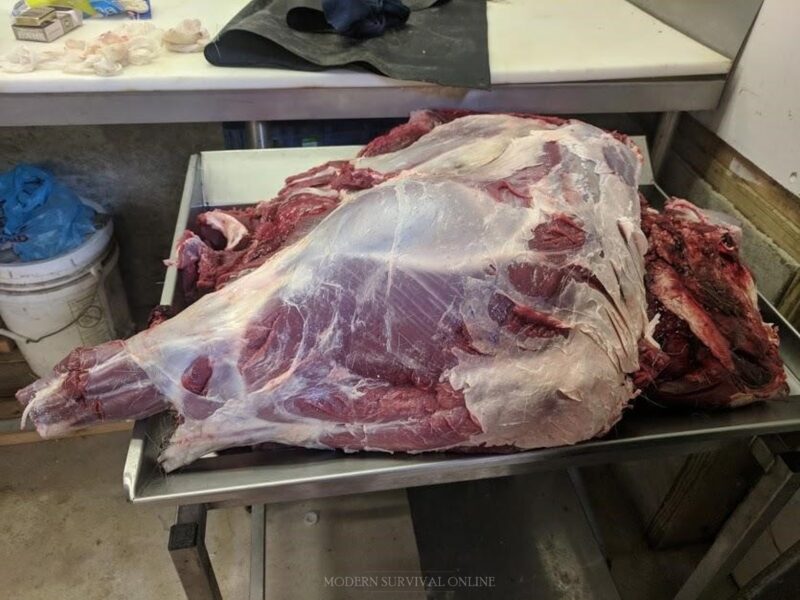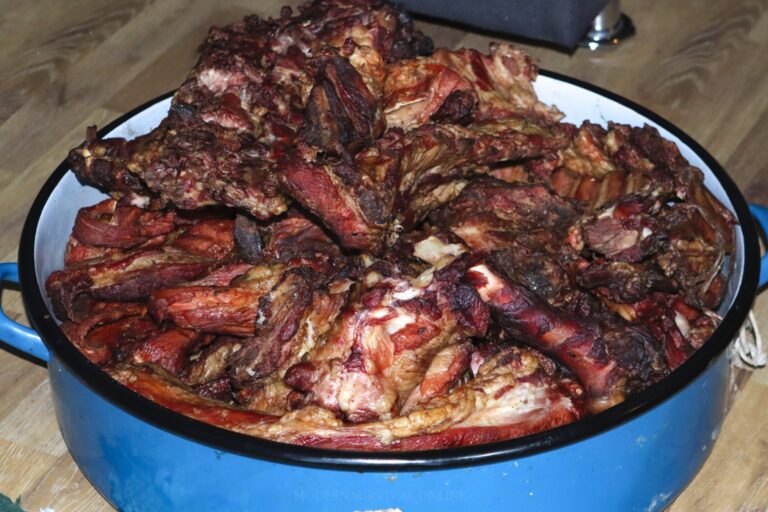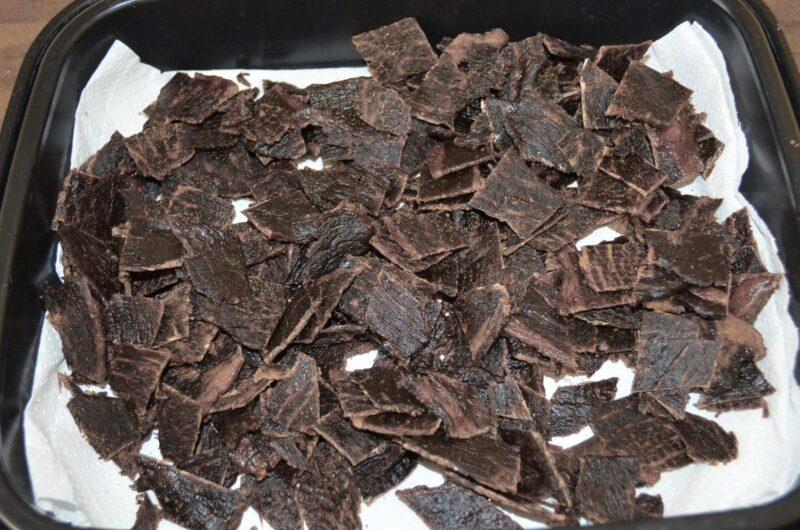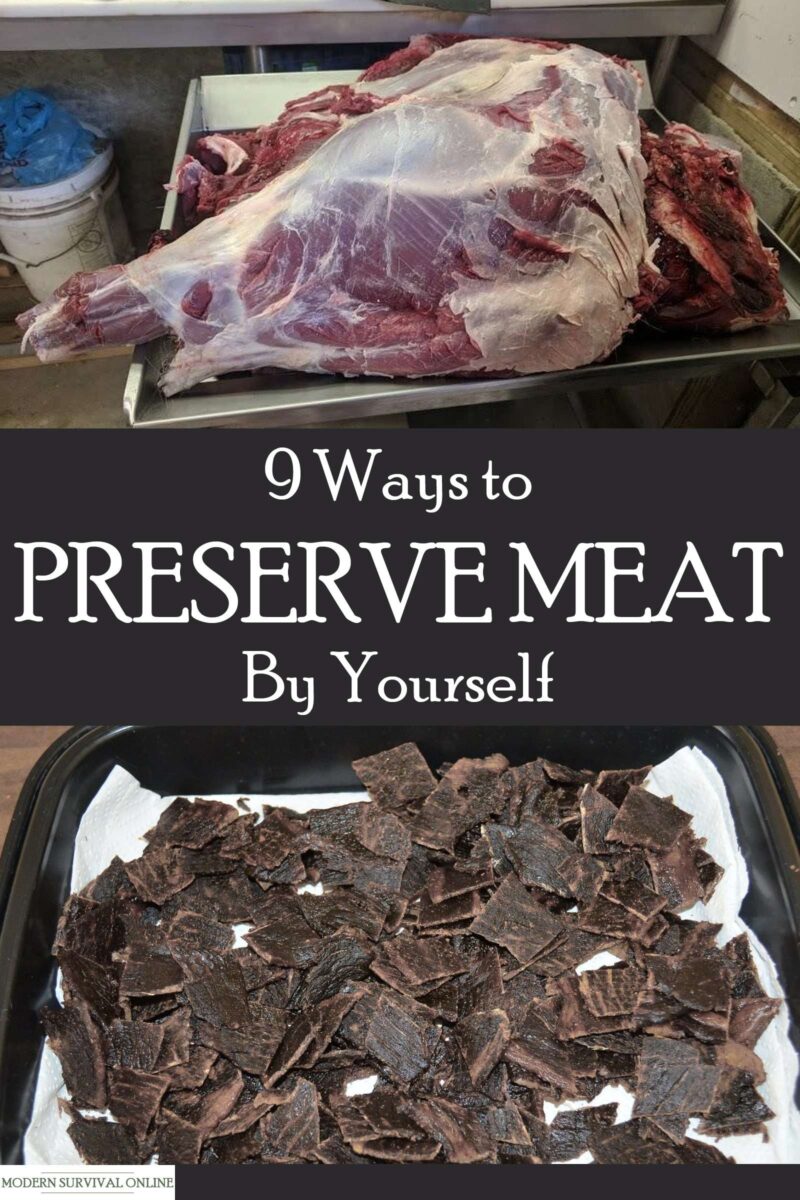If you were like me, and many other preppers, you are probably disproportionately focused on food when it comes to consumable survival supplies.

This is with good reason, of course, because food is quite literally the fuel that will provide the energy to our bodies, enabling us to not just keep on living but also perform the countless tasks that we will have to take care of in the business of survival, particularly over the long term.
Accordingly, preppers can reliably we expected to amass huge stockpiles of long-lasting, shelf stable and calorie dense food as a foundational item in their survival stash.
Whether they are ready to eat or not, having the food on hand that can “go the distance” is critical. But this facet of survival illuminates a weak spot in the skill set of many preppers.
Having the food is one thing, but knowing how to preserve it yourself is another. Meat, in particular, is one of the most valuable, well-rounded and energy dense foods that we could choose, and it is also one that is the hardest to come by out in the wild during a survival situation.
In order to get the best return on your investment and maximize every single calorie, you should know how to preserve meat effectively without benefit of modern technology. This article will show you how.
Why You Should Learn This Skill
Food is a precious resource, no doubt about it, but it is also an expensive one. No, I’m not just talking about the rising prices at the grocery store or the sneaky onset of shrinkflation.
I’m talking about the time and energy investment that is required to obtain food, particularly when you are living in an austere environment.
Unlike the popular romantic depiction of survival in remote places, food isn’t around every bush and shrub just waiting to be picked. Vegetables, fruits, seeds and mushrooms, even at their most abundant, our only found in certain places and in certain seasons.
You’ll face challengers in the form of other inhabitants of nature, as well as spoilage and disease. Your acquisition of an adequate amount of food, even when gathering, is going to be anything but easy, and far from guaranteed.
Meat is even harder to come by, and more expensive. Whatever kind of quarry you are after you’ll have to find it and dispatch it or trap it, then clean and prepare it and then cook it.
All of these operations require a substantial investment of energy and time. In the end, you’ll be rewarded with high quality calories. But those calories won’t last.
Eat, and you’ll immediately start burning them up. Particularly if you bring down larger game, just how much of it can you, even you and your family, eat in a couple of days before it spoils?
Every good prepper knows that avoiding waste and maximizing the return on your investment, in both effort and yield, is paramount when resources are anything but guaranteed and that is why it is so critical that you learn how to preserve the fruits of your labors.
Letting the bulk of the calories that you won go to waste through spoilage is tragic and bordering on the criminal for lack of preparation.
No matter what kind of environment you are in and no matter what kind of meat you are after, rest assured that there is a way you can preserve it using what materials you have at hand.
No Power, No Problem
To further clarify, this is not going to be some instructional guide that will help you set up a robust logistical chain for firing up energy expensive modern refrigeration units or some other such trickery in remote locations.
While it might actually be viable for some, and there isn’t necessarily a reason you shouldn’t do that out of hand, that is not the kind of knowledge we are after today.
Instead, we will be discussing ancient or primitive methods for the preservation of meat that have been time tested throughout history by various cultures and in various environments for the preservation of various kinds of meat. You won’t need any electricity, refrigerant or modern appliances.
You’d probably don’t need me to tell you just how freeing this skill set can be. Knowing that you can preserve whatever meat you manage to harvest, extending its useful, safe shelf life by anywhere from several days to many months, is huge.
9 Ways to Preserve Meat On Your Own
Salting
Salting, otherwise properly known as salt curing, is likely one of the better known methods of meat preservation on this list and is one that has been used for millennia in this specific purpose.
Although it dramatically alters the taste and texture of most meat, it works so reliably because it takes a two-pronged approach to preservation, significantly altering the pH balance of the meat itself and dehydrating it by drawing out moisture.
Bacteria and other microorganisms must live in a specific environment just like any other living thing or else they will die.
By changing the pH balance of the meat to an environment that is hostile to microscopic life, and dehydrating that environment, the meat is rendered entirely untenable to the presence of most microorganisms, including the kind that calls decay.
Salted meats have long been used for creating stable, dependable long haul rations for soldiers, sailors, explorers and other folks who need to go the distance while still eating good.
It is also worth noting that salt curing, for all of its practical benefits, over time resulted in cultural and regional dishes that have unique and highly sought after flavor profiles. In other words, salted meats generally taste pretty good.
The wide availability of salt and the ease with which this method can be implemented in remote environments should make this a mainstay in your arsenal.
Sugaring
Sugaring is a method of meat preservation which works very similarly to salting. As with salting, sugaring is intended to draw out moisture from the meat as a primary mechanism of preservation and also results in some alteration of the pH balance as a secondary mechanism.
Properly implemented, meat that is packed in crystal sugar or immersed in liquid sugar syrup should keep for far longer than normal.
Although thought of as a method of meat preservation that has largely become popular in the 20th century, it has actually been around for far longer in the form of honey preservation (honeying) which works on exactly the same principle.
However, compared to salting, sugaring has some significant drawbacks, drawbacks that are bad enough to actually negate any theoretical benefits of doing so.
If performed incorrectly or time drawn sugaring might actually have the opposite intended effect, suffusing the meat with more moisture which will indeed provide bacteria with an environment ripe for flourishing.
Furthermore, sugaring can often give rise to outbreaks of yeast which will subsequently result in fermentation and spoilage of your meat.
The bottom line is that sugaring is tricky, and has drawbacks compared to salting but it can be done with success as has been proven throughout history. If sugar or honey is widely available in your area this is definitely a method that you should learn and practice.
Drying
Drying is another ubiquitous and well known method of meat preservation, and one that presents evidence of it having been used going many, many millennia back into prehistory.
Used for the preservation of all kinds of meats by all kinds of cultures around the world, there is no meat on Earth that cannot be successfully dried for preservation so long as a little care and attention to detail is employed.
Drying works, as the name entails, by eliminating moisture in the meat. Without moisture, most bacteria and other microorganisms cannot survive, including mold, yeast and other nasty critters.
This will not entirely eliminate decay and degradation of the meat, but it will radically slow it down, greatly extending the safe shelf life.
One of the best attributes of drying as a method of preservation is how adaptable and versatile it is. There are many ways to drive food, including simple open-air drying, solar drying, hot air convection and others.
Even better, drying can function as an excellent step in a two-step procedure using other methods of preservation, greatly extending the longevity of your hard-earned meat. However, some people take issue with dried meats when it comes to taste and texture.
We all know someone that, somehow, does not like beef jerky and similar foods but if you view these meats in the context of survival rations and not luxury cuisine they should remain plenty palatable.
Smoking
Smoking is another ancient and undoubtedly effective method of meat preservation, and those sometimes thought of as a subset of drying, that is not the whole story.
Smoking indeed does most of its work by dehydrating the meat and killing off microorganisms inside via dehydration as described above, but compared to other drying methods it also heats the meat, further destroying any lurking, microscopic critters and drying out the meat even more rapidly.

Probably its most stellar attribute is its taste profile, not to mention its adaptability. There is hardly an animal alive that does not taste better when it has been smoked, and you can smoke meat from mammals, reptiles, fish and birds of all kinds to produce a fine, delicious meal.
Even better, there are many ways to set up an effective smoking arrangement in an austere environment.
However, the biggest and most obvious shortcoming with smoking is that it is a heat intensive method of preserving meat, and that means you’ll need plenty of fuel as well as a reliable way to get a fire going and maintained in order to employ it.
Smoking, like other methods, requires patience and a fair bit of attention to pull off correctly, but the results definitely make it worth it.
Chilling
Heading in the other direction when it comes to the preservation of meat, chilling, or refrigeration, is one method that we are all likely familiar with, ubiquitous as modern refrigerator appliances are.
Chilling meat in order to preserve it is massively effective, no doubt about it, and you should count yourself lucky in that regard if you live in an area that can furnish you with wild caught meat and is also cold enough where you won’t have to work very hard in order to keep it at low temperature.
In such an environment, doing little more than wrapping the meat in something to help keep it clean and storing it in such a way as to protect it from scavengers and other creatures that would chow down on it is all that is required.
Even if you live or are surviving in an area where the temperature range is right on the edge for effective and reliable chilling, it is easy enough to either dig into the ground or find some other isolated location where the temperature will remain more or less stable around the clock.
Keep in mind you don’t necessarily have to rely on above ground storage in order to take advantage of chilling.
Keeping your meat in caves, deep underground or even sealed securely in a plastic food storage bag and immersed in a cold running stream or other body of water could it prove entirely adequate for greatly increasing shelf life.
It should go without saying, but if you live in a warm or hot climate you will likely not be able to rely on chilling as a method of preservation during a crisis unless you have access to electric appliances.
Freezing
If you want the maximum possible shelf life for your meat, there are very few methods that will rival or beat freezing.
Freezing technology, little more than high intensity refrigeration, has proven to be the ultimate in food preservation and is a linchpin of storing and transporting food commercially.
However, it is technology and energy intensive if you live anywhere but the coldest environments on Earth.
Freezing works by essentially placing your food in stasis as far as the microorganisms that result in decay and spoilage are concerned.
In fact, many bacteria and other forms of microscopic life will be completely destroyed upon freezing since their cellular bodies will rupture as the fluid they contain expands.
Freezing just plain works, but you’ll have to be in a perennially cold place or a place that endures hostile cold seasons in order to depend on it.
And as effective as freezing is it too has drawbacks as a method. Keeping your priorities in order, if you live in a place where you can freeze meat outdoors that means you are in danger of freezing outdoors, since you are made of meat yourself!
Exposure will be a constant concern in such places. Additionally, meat that is frozen is essentially inedible until it is thawed or cooked since it will be rock hard.
These shortcomings aside, you should definitely take advantage of freezing if you are able so long as your other requirements are met.
Burial
This is certain to be the most talked about and borderline scandalous procedure on this list.
If you are like me, you are probably thinking the same thing that I did when I first heard about it: How is it even remotely possible that digging into the ground, the filthy, bacteria laden ground, and placing fresh meat in it possibly going to help preserve it?
I’m pretty sure we were all raised to avoid exactly that eventuality to keep our food safe and edible.
Well, once you know a little bit about the mechanisms of spoilage, lacking a better word, it makes more and more sense.
I have said repeatedly throughout this article that it is the presence of bacteria and other microorganisms that result in the spoilage and decomposition of food predominantly.
So long as the environment that these bacteria live in (think the condition and status of the meat in this regard) is suitable they will happily chow down, multiply and excrete waste in a never ending cycle until you are left with a pile of rancid sludge.
But, once we deprive those same bacteria of a hospitable environment by eliminating moisture, lowering or eliminating oxygen levels and dramatically altering the pH level of the meat itself those bacteria die or they’re vital mechanisms are slowed to the point did they stop making much of a difference in the meat.
As it turns out, burying our meat can do all of the above, namely lowering the temperature and starving the bacteria of oxygen and depending upon the type of soil itself also radically lower the pH level through its alkalinity.
Burying works best with other foods like sturdy fruits and vegetables but meat can be buried effectively in conjunction with naturally sourced additives like wood ash.
Specifically, meat should be first cooked, then covered, and then completely encased in fresh wood ash inside a dug hole before the hole itself is filled back in.
Carefully following this procedure will preserve the meat for a surprisingly long time while repelling insects and mammals alike.
Stewing
The stewing of meats and other foods is yet another method that has been around for ages, certainly before recorded history.
Stewing is just another form of heating food in order to kill off and neutralize those aforementioned microorganisms that result in spoilage and, as a type of cooking, most often improves both the taste and consistency of our meat.
Though any kind of stewing will certainly raise temperatures to the point where the existence of microscopic life is impossible, this does nothing to help us once the food cools down as bacteria will once again be allowed to flourish.
Therefore, stewing is best used as an interim or relatively short-term version of preservation.
However, assuming one has enough fuel on hand to maintain the required temperature long enough it is possible to perpetually stew meats and other foods in order to keep them fresh and safe to eat.
In various cultures around the world and in several renowned restaurants around the globe genuine perpetual stews have been maintained for months or even years in this way, completely safe to eat.

Conversion
Conversion is a method of preserving meat whereby one converts it into a dedicated survival ration, usually by combining it with other ingredients, cooking or a combination thereof.
Out of all the methods of meat preservation available to us, this is one that has the most cultural overtones, since pretty much every culture and every time throughout history developed their own way of turning meat into a ration capable of traveling long distances without spoiling.
Readers are likely already familiar with terms like jerky, pemmican, and biltong, as these are just some of the most well-known methods of preserving meat by combining it with other ingredients.
These ingredients definitely improve taste and nutrition, no doubt about it, but when combined with cooking or other methods of preservation also serve to work in tandem, further increasing shelf life and safety of the food.
Compared to all of the other methods on this list it is conversion that is likely to take the longest and be the most involved as it will entail, necessarily, quite a few more steps then it preserving the meat by itself.
You might have to process several ingredients using lengthy procedures in order to, finally, combine them in your recipe and then perform any final steps before your meat is ready to travel.
Even so, the finished product usually proves itself as one of the most stable, most playable and energy dense food sources that remains compact and easy to store and carry, in other words, picture perfect survival food, which is what many of these dishes started out as.
This is one method of preservation that I highly encourage all preppers to learn everything they can about, and to experiment with.
Conclusion
Every prepper must be diligent to reduce waste and prevent the loss of essential resources through careful preservation, and perhaps nowhere is this more vital than when it comes to our food.
Meat is an incredibly precious resource in a survival situation, and if you are fortunate enough to bring down larger game they can provide you with a substantial yield of nutritious meat, you must act swiftly and correctly if you want to preserve it in an austere environment.
The nine methods presented above will furnish you ample means to do that in any environment.


Like what you read?
Then you're gonna love my free PDF, 20 common survival items, 20 uncommon survival uses for each. That's 400 total uses for these dirt-cheap little items!
We will not spam you.